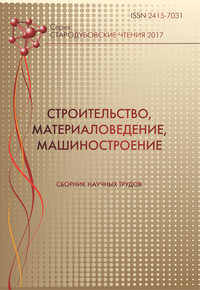Nanomodified gypsum binder
Keywords:
nanotechnology, gypsum binder, Taurit, additives plasticizers, properties, impactAbstract
Summary. Statement of the problem. Trends in the development of nanotechnology in the field of construction aimed at the development of products with improved quality and functional characteristics, improved utilization of existing materials. Gypsum binder in comparison with others is more environmentally friendly and less dangerous for the workers. Therefore, the deficiencies of gypsum binder, will expand its scope and improve a number of technological factors. Goal. Obtaining gypsum binder with high strength characteristics. The methodology of the research. When conducting research using the standard methods of determining the properties of the gypsum binder. The primary material. The most effective among the studied is the additive sica Viscocrete G; since there is a significant plasticizing effect with a significant increase in strength characteristics (bending strength 70% compressive strength 40%) and sufficiently slow setting time – 12 to 29 minutes (end of setting). Taurit is a natural polymer of the cluster type, having in its structure both organic and mineral parts that are not similar to the already known fossil based carbonaceous minerals. Despite the increase in vodopiyanova relations, introduction to composition Taurito leads to an increase in strength. It should be noted that the introduction of the compositions of the Taurito allows to obtain an absolutely smooth surface of the samples without visible to the naked eye since. Conclusions. Introduction to the composition of the gypsum binder additives plasticizers can significantly reduce vedogiovane attitude. Add to compositions of modified binder Taurito leads to a slight (2%) increase water gupsum relationships and increase strength. On the basis of the obtained results was determined the optimal compositions of modified gypsum binder.References
Voytovich, E. V. Novyie vidyi gipsovyih vyazhuschih s primenim nanomodifikatorov [New types of gypsum binders applicable to the nanomodifiers]/ E. V. Voytovich, I. V. Zhernovskiy, A. V. Cherevatova // Suhie stroitelnyie smesi. – 2011. - №3. – S. 18-19.
Voytovich, E. V. Osobennosti fazoobrazovaniya v kompozitsionnom nanostrukturirovannom gipsovom vyazhuschem [Peculiarities of phase formation in nanostructured composite gypsum binder] / E. V. Voytovich, I. V. Zhernovskiy, A. V. Cherevatova, V. V. Strokova // Stroitelnyie materialyi. – 2012. - №7. –S. 9-11.
DSTU B V.2.7-82:2010. Budivelni materiali. V’yazhuchi gipsovi. Tehnichni umovi [Building materials. Gypsum binders. Specifications]. – KiYiv.: Minregionbud UkraYini, 2010.
Kondrateva, N. V. Nanotehnologii v proizvodstve stroitelnyih materialov [Nanotechnologies in production of construction materials] / N. V. Kondrateva // BudIvnitstvo UkraYini. – 2012. - №6. - S. 2-9.
Korolev, E. V. Nanotehnologii v stroitelnom materialovedenii. Analiz sostoyaniya i dostizheniy. Puti razvitiya [Nanotechnology in construction material science. Analysis of the status and achievements. The path of development]. / E. V. Korolev // Stroitelnyie materialyi. - 2014. –№11. - S. 47-78. Строительство, материаловедение, машиностроение: Стародубовские чтения – 2017 77
Maeva, I. S. Modifikatsiya angidritovyih kompozitsiy mnogosloynyimi uglerodnyimi nanotrubkami [Modification of anhydrite compositions with multilayer carbon nanotubes] / I. S. Maeva, G. I. Yakovlev, G. N. Pervushin, A. F. Buryanov, R. Machyulaytis // Stroitelnyie materialyi. – 2010. - №7. – S. 25-27.
Maeva, I. S. Strukturirovanie angidritovoy matritsyi nanodispersnyimi modifitsiruyuschimi dobavkami [Structuring of anhydrite matrix of the modifying additives of nanodispersed] / I. S. Maeva, G. I. Yakovlev, G. N. Pervushin, A. F. Buryanov, A. P. Pustovgar // Stroitelnyie materialyi. – 2009. - №6. – S. 4-5.
Tokarev, Yu. V. O mehanizme vliyaniya aktivnyih dobavok na osnove magnezita i uglerodnyih nanotrubok na strukturu i svoystva angidritovogo vyazhuschego [On the mechanism of the effect of active additives on the basis of magnesite and of carbon nanotubes on the structure and properties of anhydrite binder] / Yu. V. Tokarev, D. V. Golovin, A. F. Buryanov, Huygang Tshyao, Tao Du // Stroitelnyie materialyi. – 2015. - №2. – S.56-62.
Falikman, V. R. Nanomaterialyi i nanotehnologii v sovremennyih betonah [Nanomaterials and nanotechnologies in modern concretes] / V. R. Falikman // Promyishlennoe i grazhdanskoe stroitelstvo. - 2013. - №1. - S.31-34.
Downloads
Published
Issue
Section
License
Редакція Видання категорично засуджує прояви плагіату в статтях та вживає всіх можливих заходів для його недопущення. Плагіат розглядається як форма порушення авторських прав і наукової етики.
При виявлені у статті більш ніж 25% запозиченого тексту без відповідних посилань та використання лапок, стаття кваліфікується як така, що містить плагіат. У цьому випадку стаття більше не розглядається редакцією, а автор отримує перше попередження.
Автори, в статтях яких повторно виявлено плагіат, не зможуть публікуватися в усіх журналах Видавництва ДВНЗ «Придніпровська державна академія будівництва та архітектури».
Автори, які публікуються у цьому журналі, погоджуються з наступними умовами:
- Автори залишають за собою право на авторство своєї роботи та передають журналу право першої публікації цієї роботи на умовах ліцензії Creative Commons Attribution License, котра дозволяє іншим особам вільно розповсюджувати опубліковану роботу з обов'язковим посиланням на авторів оригінальної роботи та першу публікацію роботи у цьому журналі.
- Автори мають право укладати самостійні додаткові угоди щодо неексклюзивного розповсюдження роботи у тому вигляді, в якому вона була опублікована цим журналом (наприклад, розміщувати роботу в електронному сховищі установи або публікувати у складі монографії), за умови збереження посилання на першу публікацію роботи у цьому журналі.
- Політика журналу дозволяє і заохочує розміщення авторами в мережі Інтернет (наприклад, у сховищах установ або на особистих веб-сайтах) рукопису роботи, як до подання цього рукопису до редакції, так і під час його редакційного опрацювання, оскільки це сприяє виникненню продуктивної наукової дискусії та позитивно позначається на оперативності та динаміці цитування опублікованої роботи (див. The Effect of Open Access).

